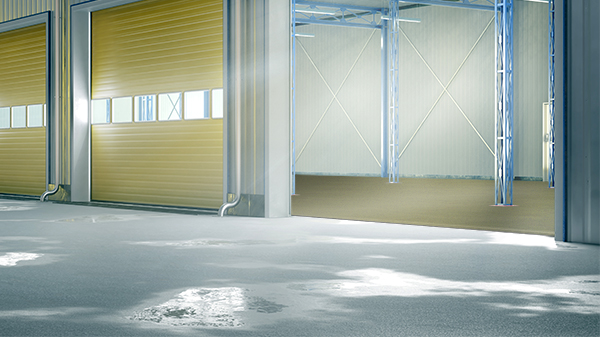Cooler temperatures can present a big potential problem when applying an epoxy coating to a concrete floor: amine blush and slow cure times. It’s a problem that’s common during the colder months but can also be an issue for floors in refrigerated, cold storage areas.
As temperatures drop in the fall, winter and early spring, especially in northern climates, applying epoxy coatings to concrete floors starts to become a challenge. Even though most jobs take place indoors, the buildings are often poorly conditioned spaces; some buildings can even be completely exposed to outdoor temperatures.
Most epoxy coatings cure very slowly below 50 degrees F, if at all. The temperature slows the reaction, and the coating can just stay wet for much longer than intended.
Making matters worse, these conditions are prime for amine blush.
What is Amine Blush?
Amine blush is a thin, waxy film that occurs in moist and/or cool conditions. It shows up on top of epoxy coatings, ultimately preventing topcoats from adhering properly. Sometime amine blush on concrete floors is obvious, revealing itself as a haze of oily film or even droplets. But sometimes it can be virtually imperceptible, found only by close inspection.
Amine blush can happen in a variety of environments, even in heated, insulated spaces. If there is an overhead door or other opening that allows cool or moist air inside, amine blush can form around the edges of the floor or near the opening.
Frequently direct-fired heaters are used to heat areas to improve the cure times of epoxy coatings. But watch out! Heaters can exacerbate amine blush issues due to the excess carbon dioxide and moisture that they emit.
Amine blush on concrete floors can also be a year-round issue when coating floors in cold storage facilities. No matter when it occurs, it can lead to coating system failures and dissatisfied customers.
How to Avoid It
The good news is just a few areas of amine blush can be cleaned off the surface. If you’re working in a heated space and notice those areas, a common detergent or light sanding can remove it.
But for jobs open to cooler temperatures, cleaning amine blush and painfully slow cure times aren’t an option. Here’s what’s recommended:
Use a fast-set epoxy. Our highly successful WearCOAT 440FS 100% solids epoxy mid-coat is available in a fast-set formulation. It cures quickly in temps as low as 40 degrees F. But even this specially formulated product is not impervious to blush so you still may need to do some cleaning.
Use a different technology. If the temperatures and humidity really get in the way and you’re worried about amine blush, you might consider a polyaspartic coating.
Polyaspartic floor coatings, like CFI’s WearCOAT 2020 and WearCOAT 2035 cure in temperatures as low as 25 degrees F, and they are not at all susceptible to amine blush. The trade-off with the faster cure rate is that you have less working time to apply the coating.
Once blush is out, use a urethane topcoat. Urethanes are a good choice in a variety of jobs, including cold temperatures, outdoor surfaces, vertical surfaces, and even steel substrates. For concrete floors, products like our WearCOAT 100 will cure at temps as low as 25 degrees F, while offering superb long-term performance.
If you have questions about amine blush or need help with a specific project, contact Customer Support, and we’ll get you a fast answer.

